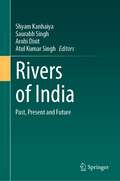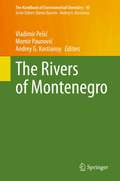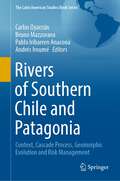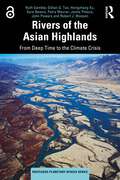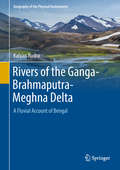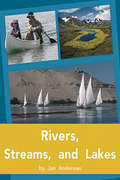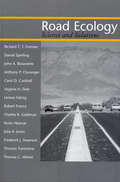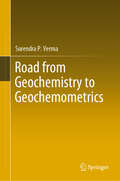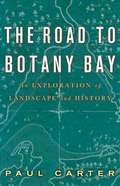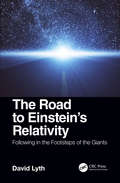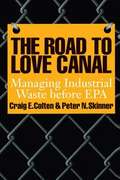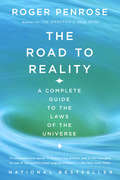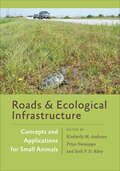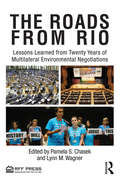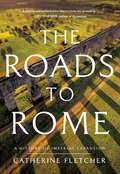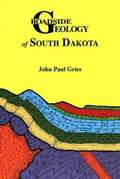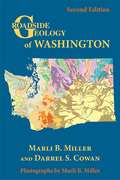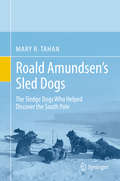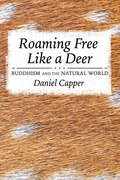- Table View
- List View
Rivers of India: Past, Present and Future
by Shyam Kanhaiya Saurabh Singh Arohi Dixit Atul Kumar SinghThis volume presents geological, geographical, environmental, and agriculture related studies on rivers, focusing on basins of the three geomorphic divisions of India, i.e. peninsular India, Indo-Gangetic plain and extra-peninsular India. The book compiles data on both the small and large river systems of India, the large rivers include Jhelum, Ghaghara, Narmada, Son, Krishna and Godavari; and the small scale, rain-fed and groundwater-fed rivers such as Gomti have been studied. The chapters comprehensively provide assessments of geomorphological aspects, river sediment supply, clean water availability for human population, ground water recharge, flood management and irrigation. The information presented in this book will appeal to students, teachers, researchers and planners engaged in river development, management and conservation.
The Rivers of Montenegro (The Handbook of Environmental Chemistry #93)
by Vladimir Pešić Momir Paunović Andrey G. KostianoyThis book reviews the current state of knowledge on, recent advances in, and future prospects of Montenegrin river basins in the context of anthropogenic activities. Edited by three respected experts in the field, the book begins with an introduction to the specific hydrogeological conditions in Montenegro and critical reflections on the impact of hydropower projects. It then reviews the vulnerability of river ecosystems, exploring potential genotoxic effects and water quality, and explaining typology and monitoring of these aspects, and particularly highlighting mollusk assemblages and monitoring of intermittent rivers. The closing chapters focus on the impact of river flooding and discuss controversial projects aiming to find an approach mutually acceptable to all stakeholders. Given its scope, the book is an indispensable resource for scientists in academia and the water industry, as well as for decision-makers in the field investigating the interactions between land and water, limnology and biota, and natural and cultural resources.
Rivers of Power: How a Natural Force Raised Kingdoms, Destroyed Civilizations, and Shapes Our World
by Laurence C. SmithAn "eye-opening, sometimes alarming, and ultimately inspiring" natural history of rivers and their complex and ancient relationship with human civilization (Elizabeth Kolbert, Pulitzer Prize-winning author of The Sixth Extinction).Rivers, more than any road, technology, or political leader, have shaped the course of human civilization. They have opened frontiers, founded cities, settled borders, and fed billions. They promote life, forge peace, grant power, and can capriciously destroy everything in their path. Even today, rivers remain a powerful global force -- one that is more critical than ever to our future.In Rivers of Power, geographer Laurence C. Smith explores the timeless yet underappreciated relationship between rivers and civilization as we know it. Rivers are of course important in many practical ways (water supply, transportation, sanitation, etc). But the full breadth of their influence on the way we live is less obvious. Rivers define and transcend international borders, forcing cooperation between nations. Huge volumes of river water are used to produce energy, raw commodities, and food. Wars, politics, and demography are transformed by their devastating floods. The territorial claims of nations, their cultural and economic ties to each other, and the migrations and histories of their peoples trace back to rivers, river valleys, and the topographic divides they carve upon the world. And as climate change, technology, and cities transform our relationship with nature, new opportunities are arising to protect the waters that sustain us.Beautifully told and expansive in scope, Rivers of Power reveals how and why rivers have so profoundly influenced our civilization and examines the importance this vast, arterial power holds for the future of humanity."As fascinating as it is beautifully written."---Jared Diamond, Pulitzer Prize-winning author of Guns, Germs, and Steel, Collapse, and Upheaval
Rivers of Southern Chile and Patagonia: Context, Cascade Process, Geomorphic Evolution and Risk Management (The Latin American Studies Book Series)
by Carlos Oyarzún Bruno Mazzorana Pablo Iribarren Anacona Andrés IrouméThis book provides a comprehensive analysis of the evolution of rivers affected by natural and anthropogenic disturbances in the southern Chile and Patagonia. It presents a detailed description of the rivers affected by climatic extremes, volcanic eruptions, large-wood dynamics and impacts, sediment-laden flows, and Glacier Lake Outburst Floods (GLOFs). Moreover, it contains an in-depth discussion of a variety of topics encompassing the ecosystem function of Pacific Patagonia rivers, the geomorphic signatures of Glacier Lake Outburst Floods (GLOFs) and their impacts within river corridors, as well as the assessment of the associated natural hazards and risks. Further, it provides proposals for public and territorial policies that improve the management and sustainable strategies of the hazards and risks. This book is conceived by leading researchers of the Universidad Austral de Chile and includes contributions by distinguished scholars from around the world. It attracts a wide range of readers, including scientific community, researchers, undergraduate and graduate students, and policy makers from Chile and abroad.
Rivers of Sunlight: How the Sun Moves Water Around the Earth (Sunlight Series #4)
by Molly Bang Penny ChisholmA stunning, accessible explanation of the Earth's water cycle and its global effects. In this brightly illustrated narrative, readers will learn about the constant movement of water as it flows around the Earth and the sun's important role as water changes between liquid, vapor, and ice. From sea to sky, the sun both heats and cools water, ensuring that life can exist on Earth. How does the sun keep ocean currents moving, and lift fresh water from the seas? And what can we do to conserve one of our planet's most precious resources? Perfect for any young reader eager to learn more about his or her world, this is an invaluable addition to any classroom, library, or at-home collection. With stunning artwork and compelling scientific explanation, Bang and Chisholm have brought forth a masterpiece that is critically relevant in this environmentally tumultuous time. The newest book in the award-winning Sunlight Series is an important and beautiful exploration one of our planet's delicate geological cycles, clearly and simply presented for young readers.
Rivers of Sunlight: How the Sun Moves Water Around the Earth
by Molly Bang Penny ChisholmThree-time Caldecott Honor Artist Molly Bang and National Science Award-winning professor Penny Chisholm present a stunning, accessible explanation of the Earth's water cycle and its global effects.With stunning artwork and compelling scientific explanation, Bang and Chisholm have brought forth a masterpiece that is critically relevant in this environmentally tumultuous time. How does the sun keep ocean currents moving and lift fresh water from the seas? What can we do to conserve one of our planet's most precious resources? In this newest book in the award-winning Sunlight Series, readers learn about the constant movement of water as it flows around the Earth. As the water changes between liquid, vapor, and ice, Sunlight powers all living things, ensuring that life can exist on Earth.Perfect for any reader--young or old!--this is an invaluable addition to all classrooms, libraries, and at-home collections.
Rivers of the Asian Highlands: From Deep Time to the Climate Crisis (Routledge Planetary Spaces Series)
by Ruth Gamble Gillian G. Tan Hongzhang Xu Sara Beavis Petra Maurer Jamie Pittock John Powers Robert J. WassonRivers of the Asian Highlands introduces readers to the intersecting headwaters of Asia’s eight largest rivers, focusing on the upper reaches of two river systems: the Brahmaputra’s highland tributaries in the eastern Himalayan Mountains and the Dri Chu (upper Yangzi), which descends from the Tibetan Plateau’s east through the Hengduan Mountains.This book guides its readers through these two rivers’ physical, environmental, cultural, social, and political histories before providing a multifaceted assessment of their present. It uses general and detailed insights from multiple disciplines, including anthropology, conservation, geography, geomorphology, climate science, ecology, history, hydrology, and religious studies. The rivers’ stories explain how the catchments’ hazards—earthquakes, landslides, floods, droughts, and erosion—interact with their energetic, hydrological, ecological, cultural, and social abundance.This book’s multiple cultural and disciplinary perspectives on the rivers will interest anyone who wants to understand the rivers of this critically important region as the environment faces climate change and other ecological crises.
Rivers of the Ganga-Brahmaputra-Meghna Delta: A Fluvial Account Of Bengal (Geography of the Physical Environment)
by Kalyan RudraThis is the first comprehensive book on the rivers of the Ganga-Brahmaputra-Meghna delta. This volume covers all aspects of this highly populated region including land conflicts and environmental impacts such as the Indo-Bangladesh conflict over sharing of trans-boundary water. This book addresses the topic from a highly interdisciplinary perspective covering areas of geography, geology, environment, history, archaeology, sociology and politics of the Bengal region.The book appeals to a wide range of audiences from India, Bangladesh and the international community. The style of presentation makes it easily suitable for students, researchers and interested laymen.
Rivers, Streams, and Lakes (Rigby PM Plus Blue (Levels 9-11), Fountas & Pinnell Select Collections Grade 3 Level Q)
by Jan AndersonRivers, Streams, and Lakes by Jan Anderson
Road Ecology: Science and Solutions
by Virginia H. Dale Daniel Sperling Anthony P. Clevenger Richard T.T. Forman Carol D. Cutshall John A. BissonetteA central goal of transportation is the delivery of safe and efficient services with minimal environmental impact. In practice, though, human mobility has flourished while nature has suffered. Awareness of the environmental impacts of roads is increasing, yet information remains scarce for those interested in studying, understanding, or minimizing the ecological effects of roads and vehicles. Road Ecology addresses that shortcoming by elevating previously localized and fragmented knowledge into a broad and inclusive framework for understanding and developing solutions. The book brings together fourteen leading ecologists and transportation experts to articulate state-of-the-science road ecology principles, and presents specific examples that demonstrate the application of those principles. Diverse theories, concepts, and models in the new field of road ecology are integrated to establish a coherent framework for transportation policy, planning, and projects. Topics examined include: *foundations of road ecology *roads, vehicles, and transportation planning *vegetation and roadsides *wildlife populations and mitigation *water, sediment, and chemical flows *aquatic ecosystems *wind, noise, and atmospheric effects *road networks and landscape fragmentationRoad Ecology links ecological theories and concepts with transportation planning, engineering, and travel behavior. With more than 100 illustrations and examples from around the world, it is an indispensable and pioneering work for anyone involved with transportation, including practitioners and planners in state and province transportation departments, federal agencies, and nongovernmental organizations. The book also opens up an important new research frontier for ecologists.
Road Expansion in the Peruvian Amazon: The 'Enchantments' of the Manu Road (SpringerBriefs in Latin American Studies)
by Eduardo Salazar Moreira Marcela Palomino-SchalschaThis book provides in-depth insights into the construction of the first road to reach riparian communities and the main access point to a national park in the Amazonian rain forest. It is based on an ethnographic investigation in Peru’s Manu Province in the Amazon, which explored diverse local attitudes towards the construction of a road in the overlapping buffer zone of two protected areas: the Manu National Park and the Amarakaeri Communal Reserve. The book reveals the applicability of Harvey and Knox’s concept of ‘enchantments of infrastructure’ in the case of first roads, but also makes accessible wider debates in political ecology such as territoriality and frontier development. The promise of first roads sparks feelings of aspiration and anticipation of the advent of development through speedy travel, economic connectivity and political integration. Yet these developments seldom take shape as expected. The author explores the perspectives, social dynamics and political maneuvers that influence first road building processes in the Amazon, which have applicability to experiences and strategies of road development elsewhere.
Road from Geochemistry to Geochemometrics
by Surendra P. VermaThis book highlights major problems in the statistical analysis of compositions that have been known for over a century, as well as the corresponding solutions that have been put forward by specialists over the past 30 years. The basic assumptions of normality or multi-normality are pointed out and methods to test and achieve them are also covered. The conventional major and trace element geochemistry and modeling equations are discussed, and are followed by a more sophisticated multidimensional approach to data handling. The book’s main focus is on the use of statistical techniques to facilitate data interpretation. It also highlights the classification (or nomenclature) and tectonic discrimination aspects for both igneous and sedimentary rocks. The book concludes by discussing computer programs that are helping pave the way from geochemistry to geochemometrics. Written by a leading expert in the area of geochemistry, it offers a valuable guide for students and professionals in the area.
The Road to Botany Bay: An Exploration of Landscape and History
by Paul CarterThe Road to Botany Bay, first published in 1987 and considered a classic in the field of cultural and historical geography, examines the poetic constitution of colonial society. Through a far-reaching exploration of Australia&’s mapping, narrative description, early urbanism, and bush mythology, Paul Carter exposes the mythopoetic mechanisms of empire. A powerfully written account of the ways in which language, history, and geography influenced the territorial theater of nineteenth-century imperialism, the book is also a call to think, write, and live differently.
The Road to Einstein's Relativity: Following in the Footsteps of the Giants
by David LythCHOICE Highly Recommended Title, August 2019 <P><P>Expertly guided by renowned cosmologist Dr. David Lyth, learn about the pioneering scientists whose work provided the foundation for Einstein’s formulation of his theories of relativity, and about Einstein's groundbreaking life and work as well. <P><P>This highly readable and accessible panorama of the field delicately balances history and science as it takes the reader on an adventure through the centuries. Without complex mathematics or scientific formulae, this book will be of interest to all, even those without a scientific background, who are intrigued to find out more about what paved the way for one of our most famous physicists to push the boundaries of physics to new lengths. <P><P>Features: <li>Written by an internationally renowned physicist and cosmologist <li>Describes the life and times of Einstein and his important predecessors <li>Focuses on one of the most famous areas of science, Einstein’s Relativity Theory
The Road to Love Canal
by Craig E. Colten Bruce Piasecki Peter N. SkinnerThe toxic legacy of Love Canal vividly brought the crisis in industrial waste disposal to public awareness across the United States and led to the passage of the Superfund legislation in 1980. To discover why disasters like Love Canal have occurred and whether they could have been averted with knowledge available to waste managers of the time, this book examines industrial waste disposal before the formation of the Environmental Protection Agency in 1970. Colten and Skinner build their study around three key questions. First, what was known before 1970 about the hazards of certain industrial wastes and their potential for causing public health problems? Second, what were the technical capabilities for treating or containing wastes during that time? And third, what factors other than technical knowledge guided the actions of waste managers before the enactment of explicit federal laws? The authors find that significant information about the hazards of industrial wastes existed before 1970. Their explanations of why this knowledge did not prevent the toxic legacy now facing us will be essential reading for environmental historians and lawyers, public health personnel, and concerned citizens.
Road to Net Zero: Strategic Pathways for Sustainability-Driven Business Transformation
by Oliver Zipse Joachim Hornegger Thomas Becker Markus Beckmann Michael Bengsch Irene Feige Markus SchoberWith this open access book, delve into the insights of respected leaders from academia and industry as they unravel the intricacies of sustainability-driven business transformation. This meticulously curated edited volume reflects on The Road To Net Zero, underscoring the need for pioneering pathways. Embark on a collaborative learning journey and explore key issues along the road to transformation, such as crafting corporate sustainability strategies, new forms of corporate disclosure, transforming value chains, and harnessing the power of technological innovation. Packed with guiding questions and distilled findings from research, this book is a must-read for all decision-makers, strategists, engaged citizens, educators, and learners committed to driving change and shaping a more sustainable future.
The Road to Reality: A Complete Guide to the Laws of the Universe
by Roger PenroseFrom one of our greatest living scientists, a magnificent book that provides, for the serious lay reader, the most comprehensive and sophisticated account we have yet had of the physical universe and the essentials of its underlying mathematical theory.Since the earliest efforts of the ancient Greeks to find order amid the chaos around us, there has been continual accelerated progress toward understanding the laws that govern our universe. And the particularly important advances made by means of the revolutionary theories of relativity and quantum mechanics have deeply altered our vision of the cosmos and provided us with models of unprecedented accuracy. What Roger Penrose so brilliantly accomplishes in this book is threefold. First, he gives us an overall narrative description of our present understanding of the universe and its physical behaviors–from the unseeable, minuscule movement of the subatomic particle to the journeys of the planets and the stars in the vastness of time and space.Second, he evokes the extraordinary beauty that lies in the mysterious and profound relationships between these physical behaviors and the subtle mathematical ideas that explain and interpret them. Third, Penrose comes to the arresting conclusion–as he explores the compatibility of the two grand classic theories of modern physics–that Einstein’s general theory of relativity stands firm while quantum theory, as presently constituted, still needs refashioning.Along the way, he talks about a wealth of issues, controversies, and phenomena; about the roles of various kinds of numbers in physics, ideas of calculus and modern geometry, visions of infinity, the big bang, black holes, the profound challenge of the second law of thermodynamics, string and M theory, loop quantum gravity, twistors, and educated guesses about science in the near future. In The Road to Reality he has given us a work of enormous scope, intention, and achievement–a complete and essential work of science
Roads and Ecological Infrastructure: Concepts and Applications for Small Animals (Wildlife Management and Conservation)
by Kimberly M. Andrews, Priya Nanjappa and Seth P. D. RileyA practical guide that explains how we can design roads that are compatible with populations of small wildlife.Few of us think twice about driving on roads. Yet the very presence of roads and the act of driving on them can impact the ecological infrastructure that supports an animal's daily life. What chance does a turtle have of successfully laying its eggs when it needs to traverse a busy highway? Is it realistic to expect small mammals to breed when an interstate thoroughfare subdivides their population? These are the sorts of challenges faced by small, often slow-moving, animals, challenges that road engineers and ecologists are trying to address.For countless small species, vehicles traveling at high speeds are nothing less than missiles shooting across migration pathways. For too many animals, the danger can lead to the loss of populations, in part because they simply are not programmed to react to traffic. Salamanders faced with a two-lane road between the forest and their aquatic breeding site, for example, will typically cross that road regardless of the congestion. The result can be hundreds of flattened animals in a single night.Roads and Ecological Infrastructure is the first book to focus on reducing conflict between roads and small animals. Highlighting habitat connections and the challenges and solutions from both transportation and ecological perspectives, the volume covers various themes, including animal behavior related to roads and design approaches to mitigate the negative effects of roads on wildlife. The chapter authors—from transportation experts to university researchers—each promote a goal of realistic problem solving. Conceptual and practical, this book will influence the next decade or more of road design in ecologically sensitive areas and should prevent countless unnecessary wildlife fatalities.Published in association with The Wildlife Society.
The Roads from Rio: Lessons Learned from Twenty Years of Multilateral Environmental Negotiations
by Pamela S. Chasek Lynn M. WagnerAt the 1992 United Nations Conference on Environment and Development, popularly known as the Rio Earth Summit, the world’s leaders constructed a new "sustainable development" paradigm that promised to enhance environmentally sound economic and social development. Twenty years later, the proliferation of multilateral environmental agreements points to an unprecedented achievement, but is worth examining for its accomplishments and shortcomings. This book provides a review of twenty years of multilateral environmental negotiations (1992-2012). The authors have participated in most of these negotiating processes and use their first-hand knowledge as writers for the International Institute for Sustainable Development’s Earth Negotiations Bulletin as they illustrate the changes that have taken place over the past twenty years. The chapters examine the proliferation of meetings, the changes in the actors and their roles (governments, nongovernmental organizations, secretariats), the interlinkages of issues, the impact of scientific advice, and the challenges of implementation across negotiating processes, including the Framework Convention on Climate Change, the Convention to Combat Desertification, the Convention on Biological Diversity, the Commission on Sustainable Development, the UN Forum on Forests, the chemicals conventions (Stockholm, Basel and Rotterdam), the Montreal Protocol on Substances that Deplete the Ozone Layer, the Convention on International Trade in Endangered Species, the Convention on Migratory Species and the International Treaty on Plant Genetic Resources for Food and Agriculture.
The Roads to Rome: A History of Imperial Expansion
by Catherine FletcherInspired by original research and filled with color and drama, this is an exploration of two thousand years of history as seen through one the greatest imperial networks ever built."All roads lead to Rome&” is a medieval proverb, but it's also true: today's European roads still follow the networks of the ancient empire—and these ancient roads continue to grip our modern imaginations as a physical manifestation of Rome&’s extraordinary greatness. Over the two thousand years since they were first built, these roads have been walked by crusaders and pilgrims, liberators and dictators, but also by tourists and writers, refugees and artists. As channels of trade and travel—and routes for conquest and creativity—Catherine Fletcher reveals how these roads forever transformed the cultures, and intertwined the fates, of a vast panoply of people across Europe and beyond. The Roads to Rome is a magnificent journey into a past that remains intimately connected to our present. Traveling from Scotland to Cádiz to Istanbul and back to Rome, the reader meanders through a series of nations and empires that have risen and fallen. Along the way, we encounter spies, bandits, scheming innkeepers, a Byzantine noblewoman on the run, young aristocrats on their Grand Tour, a conquering Napoleon, John Keats, the Shelleys, the abolitionist Frederick Douglass, and even Mussolini on his motorbike. Reflecting on his own walk on the Appian Way, Charles Dickens observed that here is "a history in every stone that strews the ground.&” Based on vibrant original research, this is the first narrative history to tell the full story of life on the roads that lead to Rome.
Roadside Geology of South Dakota
by John P. Gries James GriesemerA layperson's geological road map describing rocks and landforms along South Dakota's highways, as well as the geology lying beneath in caves and mine shafts. Gries (geology, South Dakota School of Mines) keeps it simple but informative, traveling from the glaciated prairies, across the Missouri River, and into the rugged Badlands Wall, the Needles, and the Homestake gold mine in the the West. Stops along the way include geologic tours of the Black Hills, Mount Rushmore, Wind Cave National Park, and Jewel Cave National Monument. Includes maps and photographs. Annotation c. by Book News, Inc., Portland, Or.
Roadside Geology of Washington (2nd Edition)
by Marli B. Miller Darrel S. CowanWashington is alive with geologic activity: It’s home to the most active volcanoes in the lower 48, earthquakes regularly rattle the populated Puget Sound region, the potential of landslides increases with each soaking rain, and tsunami evacuation routes alert tourists in Olympic National Park to the active plate boundary just off the coast. With the help of this completely updated second edition, you can appreciate spectacular geologic features along more than forty of Washington’s highways.
Roald Amundsen’s Sled Dogs: The Sledge Dogs Who Helped Discover the South Pole
by Mary R. TahanThis book is an analytical account of how Roald Amundsen used sledge dogs to discover the South Pole in 1911, and is the first to name and identify all 116 Polar dogs who were part of the Norwegian Antarctic Expedition of 1910–1912. The book traces the dogs from their origins in Greenland to Antarctica and beyond, and presents the author’s findings regarding which of the dogs actually reached the South Pole, and which ones returned.Using crewmember diaries, reports, and written correspondence, the book explores the strategy, methodology, and personal insights of the explorer and his crew in employing canines to achieve their goal, as well as documents the controversy and internal dynamics involved in this historic discovery. It breaks ground in presenting the entire story of how the South Pole was truly discovered using animals, and how deep and profound the differences of perception were regarding the use of canines for exploration.This historic tale sheds light on Antarctic exploration history and the human-nature relationship. It gives recognition to the significant role that animals played in this important part of history.
Roaming Free Like a Deer: Buddhism and the Natural World
by Daniel CapperBy exploring lived ecological experiences across seven Buddhist worlds from ancient India to the contemporary West, Roaming Free Like a Deer provides a comprehensive, critical, and innovative examination of the theories, practices, and real-world results of Buddhist environmental ethics. Daniel Capper clarifies crucial contours of Buddhist vegetarianism or meat eating, nature mysticism, and cultural speculations about spirituality in nonhuman animals. Buddhist environmental ethics often are touted as useful weapons in the fight against climate change. However, two formidable but often overlooked problems with this perspective exist. First, much of the literature on Buddhist environmental ethics uncritically embraces Buddhist ideals without examining the real-world impacts of those ideals, thereby sometimes ignoring difficulties in terms of practical applications. Moreover, for some understandable but still troublesome reasons, Buddhists from different schools follow their own environmental ideals without conversing with other Buddhists, thereby minimizing the abilities of Buddhists to act in concert on issues such as climate change that demand coordinated large-scale human responses. With its accessible style and personhood ethics orientation, Roaming Free Like a Deer should appeal to anyone who is concerned with how human beings interact with the nonhuman environment.
Roaring Camp: The Social World of the California Gold Rush
by Susan E. JohnsonIn this thoroughly researched volume, drawing upon a wealth of primary sources, Johnson examines the world of the California Gold Rush with emphasis on race, ethnicity, and gender issues. She contrasts the conventional images of Gold Rush participants - Anglo males from the eastern U.S. heading west to sek their fortunes - with the reality. In fact, the Gold Rush brought together people from highly diverse backgrounds and forced them to interact with one another. Native Americans, Latinos from several nations, Anglos from the eastern U.S., European immigrants, and African Americans (both free and enslaved) all played key roles. Women of all backgrounds were also present in small but significant numbers, finding opportunities to work and live with unprecedented independence. Initially Gold Rush society was outside the bounds of accepted U.S. mores, forcing participants to relate to one another in new ways. As more Anglo women moved to California to join male relatives, middle-class standards were brought to bear on the "lawless" Gold Rush country.
